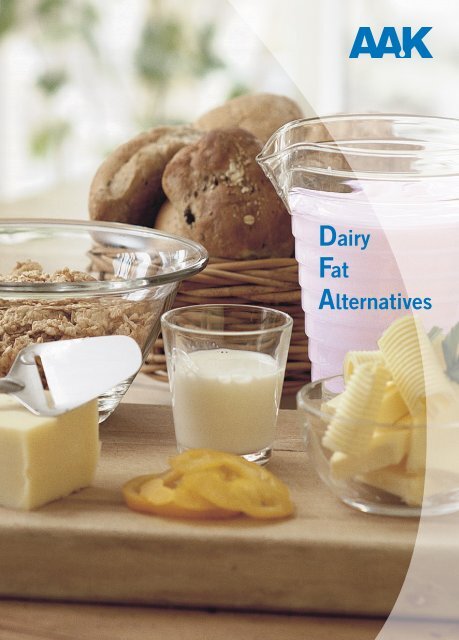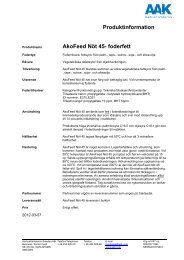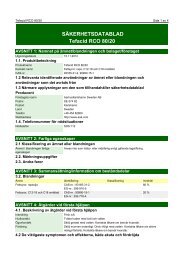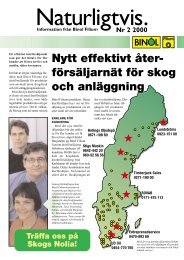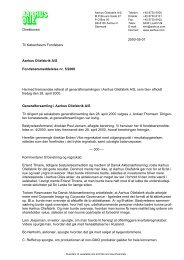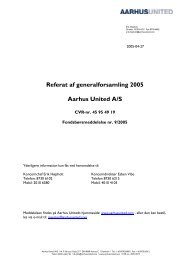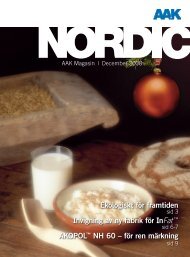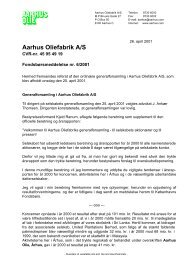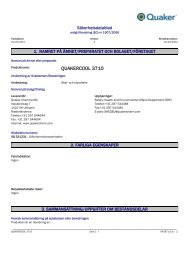DFA in dairy applications - AAK
DFA in dairy applications - AAK
DFA in dairy applications - AAK
You also want an ePaper? Increase the reach of your titles
YUMPU automatically turns print PDFs into web optimized ePapers that Google loves.
Dairy<br />
Fat<br />
Alternatives
Table of contents page<br />
<strong>AAK</strong> – your partner <strong>in</strong> creat<strong>in</strong>g solutions 3<br />
The features of AarhusKarlshamn’s <strong>DFA</strong> 4-5<br />
<strong>DFA</strong> <strong>in</strong> <strong>dairy</strong> <strong>applications</strong> 6-7<br />
Churned butter-blends 8-9<br />
Cream <strong>applications</strong> 10-11<br />
Cheese 12-13<br />
Other <strong>dairy</strong> <strong>applications</strong> 14-15<br />
Vegetable oils and fats – some basics 16-17<br />
Recipes 18<br />
Dairy Fat Alternatives<br />
2
AarhusKarlshamn<br />
– your partner <strong>in</strong> creat<strong>in</strong>g solutions<br />
Company<br />
<strong>AAK</strong> is one of the world’s lead<strong>in</strong>g producers<br />
of high value-added, speciality<br />
vegetable fats.<br />
The company’s lead<strong>in</strong>g position <strong>in</strong><br />
speciality vegetable fats was strengthened<br />
<strong>in</strong> October 2005 as a result of the merger<br />
between Aarhus United and Karlshamns.<br />
The company’s wide product portfolio<br />
meets customer requirements worldwide.<br />
Our customers represent a wide range of<br />
<strong>in</strong>dustries:<br />
n Chocolate<br />
n Confectionery<br />
n Food<br />
n Cosmetics<br />
n Technical<br />
n Feed<br />
In l<strong>in</strong>e with our customers’ needs, <strong>AAK</strong> is<br />
organised <strong>in</strong> the bus<strong>in</strong>ess areas Chocolate<br />
& Confectionery Fats, Food Ingredients,<br />
Lipids for Care, and Technical Products<br />
& Feed.<br />
Our production facilities <strong>in</strong> Denmark,<br />
Sweden, Mexico, the Netherlands,<br />
Uruguay, the UK, and the USA count<br />
2,500 employees worldwide.<br />
<strong>AAK</strong>’s objective is to supply <strong>in</strong>novative<br />
and creative, vegetable fat solutions to the<br />
benefit of our customers.<br />
Products<br />
<strong>AAK</strong>’s products are derived from natural<br />
and nutritious raw materials, e.g. palm,<br />
rape and exotic oils such as shea, illipe,<br />
sal and mango.<br />
Our products are characterized by a<br />
high degree of technology and are used <strong>in</strong><br />
such areas as cocoa butter alternatives,<br />
replacement for butter fat, solutions to<br />
elim<strong>in</strong>ate trans fatty acids as well as <strong>in</strong>gredients<br />
<strong>in</strong> functional foods.<br />
Research & Development<br />
<strong>AAK</strong>’s wide product range is the result of<br />
longstand<strong>in</strong>g, dedicated focus on research<br />
and development carried out <strong>in</strong> our own<br />
laboratories.<br />
<strong>AAK</strong>’s knowledge and expertise regard<strong>in</strong>g<br />
the properties of vegetable fats<br />
develops cont<strong>in</strong>uously through customer<br />
contacts, cooperation with<br />
research <strong>in</strong>stitutes and governmental<br />
authorities – regionally<br />
and worldwide.<br />
Our research and development<br />
takes place <strong>in</strong> close<br />
coord<strong>in</strong>ation with the customer<br />
to tailor products<br />
to meet the customer’s<br />
requirements.<br />
Service<br />
We provide local<br />
service from regional<br />
sales offices and<br />
through our network<br />
of distributors<br />
and agents<br />
worldwide.<br />
Understand<strong>in</strong>g<br />
customer needs<br />
is <strong>AAK</strong>’s bus<strong>in</strong>ess.<br />
3<br />
www.aak.com
The features of<br />
AarhusKarlshamn’s <strong>DFA</strong><br />
Milk fat has a unique composition. Its chemical<br />
and physical properties make it a generally<br />
well-accepted <strong>in</strong>gredient <strong>in</strong> many food <strong>applications</strong>.<br />
Due to cost and performance reasons, the<br />
replacement of milk fat with vegetable fat blends<br />
has been <strong>in</strong>terest<strong>in</strong>g for the food manufacturer<br />
for a long time. However, there are some differences<br />
<strong>in</strong> behaviour that one must be aware of,<br />
when mak<strong>in</strong>g this substitution. <strong>AAK</strong> has taken<br />
care to optimise these properties <strong>in</strong> the development<br />
of our range of vegetable Dairy Fat Alternative<br />
to facilitate the manufactur<strong>in</strong>g process with<br />
vegetable fats.<br />
Good taste and taste stability<br />
Due to its composition, milk fat has a characteristic<br />
creamy/buttery flavour, that vegetable fats<br />
lack. In order to replace milk fat with vegetable<br />
fats and still ma<strong>in</strong>ta<strong>in</strong> the quality of the f<strong>in</strong>ished<br />
product, the vegetable fat must have a bland<br />
taste without any off-flavour. It also has to have<br />
good flavour stability. The bland flavour and<br />
high flavour stability of <strong>AAK</strong>’s <strong>DFA</strong> products are<br />
based on careful selection of raw materials and<br />
appropriate, optimised ref<strong>in</strong><strong>in</strong>g of the oils.<br />
Improved nutritional value<br />
From a nutritional po<strong>in</strong>t of view, the high proportion<br />
of saturated fatty acids <strong>in</strong> milk fat is less<br />
desirable. Vegetable oils usually conta<strong>in</strong> less<br />
saturated fatty acids and more unsaturated fatty<br />
acids compared to milk fat and they conta<strong>in</strong> very<br />
little cholesterol. When us<strong>in</strong>g vegetable fats, <strong>in</strong><br />
comb<strong>in</strong>ation with milk fat or on their own, the<br />
balance between various fatty acids can be<br />
adjusted to a higher nutritional value.<br />
<strong>AAK</strong>’s <strong>DFA</strong> products are designed to have<br />
a beneficial nutritional profile. When necessary<br />
they can also be adjusted to fulfil different<br />
objectives. This often means that the amount of<br />
saturated fat and trans fatty acids are reduced<br />
and the mono- and polyunsaturated fatty acids<br />
are <strong>in</strong>creased. By carefully select<strong>in</strong>g and comb<strong>in</strong><strong>in</strong>g<br />
raw materials, followed by gentle process<strong>in</strong>g,<br />
<strong>AAK</strong>’s <strong>DFA</strong>s are designed to satisfy both the<br />
nutritional aspects and the functional properties<br />
of a fat for <strong>dairy</strong> application.<br />
Desired crystallisation behaviour<br />
Milk fat crystallises and is stable <strong>in</strong> the betaprime<br />
polymorph. This gives milk fat some<br />
Dairy Fat Alternatives<br />
desirable application characteristics: high crystallisation<br />
rate, good foam stabil is<strong>in</strong>g properties<br />
and small crystals. A vegetable fat, replac<strong>in</strong>g<br />
milk fat, must conform to this crystallisation<br />
pattern, especially if used <strong>in</strong> mixtures with milk<br />
fat. Depend<strong>in</strong>g on the application, the desired<br />
crystallisation behaviour differs and <strong>AAK</strong>’s extensive<br />
knowledge <strong>in</strong> this area is essential <strong>in</strong> order<br />
to develop well-perform<strong>in</strong>g products.<br />
Accurate melt<strong>in</strong>g properties and consistency<br />
Milk fat has good melt<strong>in</strong>g properties, be<strong>in</strong>g quite<br />
hard at lower temperatures and melt<strong>in</strong>g completely<br />
at body temperature. This is important for<br />
the mouth feel and flavour release when eat<strong>in</strong>g<br />
the f<strong>in</strong>ished product. A vegetable fat should have<br />
similar melt<strong>in</strong>g properties <strong>in</strong> order to replace<br />
milk fat with a ma<strong>in</strong>ta<strong>in</strong>ed quality of the f<strong>in</strong>ished<br />
product. The consistency of milk fat and vegetable<br />
fat blends is also affected by the melt<strong>in</strong>g<br />
profile, <strong>in</strong>fluenc<strong>in</strong>g for example the texture and<br />
eat<strong>in</strong>g properties of butter blends, ice-cream<br />
and cheese.<br />
While milk fat shows seasonal variations <strong>in</strong><br />
hardness, the vegetable fats are produced to an<br />
even consistency throughout the year.<br />
When air is <strong>in</strong>corporated <strong>in</strong>to the products,<br />
such as whipped cream and ice-cream, the balance<br />
between solid fat and liquid oil becomes<br />
extra important for the stability. In such cases,<br />
care is taken to adjust the solid fat content at the<br />
appropriate temperatures.<br />
Good stability and long shelf-life<br />
The stability and shelf-life of <strong>dairy</strong> products are<br />
of course mostly dependent on the hygienic<br />
conditions <strong>in</strong> the production, and on the storage<br />
conditions. The development of rancidity has<br />
also to be considered. Hydrolytic rancidity is<br />
caused by fatty acids set free dur<strong>in</strong>g storage and<br />
may be a problem with milk fat. Both milk fat<br />
and vegetable oils can also get rancid by lipid<br />
oxidation. The more unsaturated oils are more<br />
sensitive to this type of rancidity. Vegetable fat<br />
blends conta<strong>in</strong><strong>in</strong>g the nutritionally desired polyunsaturated<br />
fatty acids but with high resistance<br />
towards oxidative rancidity, are available <strong>in</strong> <strong>AAK</strong>’s<br />
<strong>DFA</strong> product range for many <strong>dairy</strong> <strong>applications</strong>.<br />
4
5<br />
Solid fat content (%)<br />
This figure illustrates how one of<br />
<strong>AAK</strong>’s <strong>DFA</strong> products, Akoblend, can<br />
be mixed with butter oil <strong>in</strong> any proportion<br />
without chang<strong>in</strong>g the consistency<br />
Stale<br />
80<br />
70<br />
60<br />
50<br />
40<br />
30<br />
20<br />
10<br />
Oxidised<br />
0<br />
35°C<br />
0/100 25/75 50/50 75/25<br />
The sensory analyse shows an<br />
oil bland taste without off-flavours<br />
Bitter<br />
Nutty<br />
0°C<br />
10°C<br />
20°C<br />
30°C<br />
Butter oil (%) Akoblend (%)<br />
Old nut<br />
L<strong>in</strong>seed oil<br />
Seed<br />
Fishy<br />
80<br />
70<br />
60<br />
50<br />
40<br />
30<br />
20<br />
10<br />
0<br />
100/0<br />
Neutral<br />
www.aak.com
<strong>DFA</strong> <strong>in</strong> <strong>dairy</strong> <strong>applications</strong><br />
The replacement of milk fat with a vegetable<br />
fat blend is often quite simple when<br />
us<strong>in</strong>g AarhusKarlshamn’s <strong>DFA</strong> products.<br />
They have been tailor-made to meet the<br />
requirements of the <strong>applications</strong>. A straight<br />
one-to-one replacement is then easily<br />
performed. In other cases there are some<br />
factors that need to be considered. Some<br />
of these are described below.<br />
Recipe<br />
When replac<strong>in</strong>g milk fat with vegetable<br />
fat <strong>in</strong> <strong>dairy</strong> products, it is recommended<br />
to start with the currently used recipe.<br />
If butter is orig<strong>in</strong>ally used <strong>in</strong> the recipe,<br />
a recalculation of the fat content has to<br />
be made, as vegetable fat is 100 % fat<br />
without any content of water. A calculation<br />
is also to be made to obta<strong>in</strong> a cream with<br />
correct fat content, from vegetable fat and<br />
skimmed milk, or other milk raw material.<br />
The vegetable fat based cream is then<br />
used <strong>in</strong> the same way as ord<strong>in</strong>ary cream.<br />
Flavour and colour<br />
In some <strong>applications</strong> the absence of a<br />
characteristic butter flavour, <strong>in</strong> vegetable<br />
Dairy Fat Alternatives<br />
fats, makes it necessary to add a flavour.<br />
Experience shows that flavour are normally<br />
not needed if the proportion of milk fat <strong>in</strong><br />
the fat blend is more than 30-50 %.<br />
Colour<strong>in</strong>g <strong>in</strong> the form of beta-carotene<br />
is normally added to the f<strong>in</strong>ished product<br />
<strong>in</strong> order to meet the different requirements<br />
for the various products and markets.<br />
<strong>AAK</strong> can add both flavour<strong>in</strong>g and colour<strong>in</strong>g<br />
agents to our products on request<br />
by the customer. This ensures safety and<br />
offers convenience <strong>in</strong> the customer’s<br />
production.<br />
Process<strong>in</strong>g and equipment<br />
Us<strong>in</strong>g <strong>AAK</strong>’s <strong>DFA</strong> products <strong>in</strong> ord<strong>in</strong>ary<br />
<strong>dairy</strong> production:<br />
n The exist<strong>in</strong>g process<strong>in</strong>g equipment can<br />
be used <strong>in</strong> most application areas.<br />
n Only m<strong>in</strong>or adjustments of the process<br />
parameters compared to ord<strong>in</strong>ary <strong>dairy</strong><br />
production.<br />
n No expensive <strong>in</strong>vestments <strong>in</strong> new<br />
equipment are required.<br />
n The productivity <strong>in</strong> the manufactur<strong>in</strong>g<br />
l<strong>in</strong>e can be ma<strong>in</strong>ta<strong>in</strong>ed or even<br />
improved.<br />
6<br />
n There will of course be a need for the<br />
<strong>in</strong>stallation of equipment for handl<strong>in</strong>g of<br />
the vegetable oil and for its <strong>in</strong>corporation<br />
<strong>in</strong>to the milk or cream.<br />
Process parameters<br />
Process parameters need normally only<br />
m<strong>in</strong>or adjustments. In some cases the<br />
vegetable fat blends crystallise more rapidly<br />
than the milk fat. The cool<strong>in</strong>g time and<br />
temperature must then be adjusted accord<strong>in</strong>gly<br />
to obta<strong>in</strong> a satisfactory product.<br />
In other cases, special attention should be<br />
given to the polymorphic behaviour of the<br />
milk fat and vegetable fat blends, and you<br />
should consult your <strong>AAK</strong> representative to<br />
obta<strong>in</strong> the appropriate handl<strong>in</strong>g <strong>in</strong>structions.<br />
Most product and process related<br />
problems can be solved by adjust<strong>in</strong>g the<br />
properties of the fat blend and/or the process<br />
parameters.<br />
Emulsification<br />
Manufactur<strong>in</strong>g of an emulsion made from<br />
the fat is the first stage <strong>in</strong> the production<br />
of vegetable fat based <strong>dairy</strong> <strong>applications</strong>.<br />
This emulsion (vegetable fat based milk
or cream) is then used as the basis for the<br />
production, see figure.<br />
When the vegetable fat is mixed <strong>in</strong>to the<br />
milk source, the result is a coarse emulsion.<br />
This coarse emulsion must, at least<br />
for some <strong>applications</strong>, be homogenised,<br />
<strong>in</strong> order to reduce the droplet size and<br />
give sufficient stability. Sometimes, for<br />
example <strong>in</strong> ice-cream and whipped cream,<br />
the properties of the emulsion are critical<br />
parameters for optimal performance <strong>in</strong> the<br />
application. In such cases the emulsification<br />
process need to be further optimised.<br />
The figure shows the process for mak<strong>in</strong>g an emulsion from the vegetable fat<br />
and milk fat and prote<strong>in</strong> source. The vegetable fat based milk or cream<br />
is then used <strong>in</strong> the ord<strong>in</strong>ary <strong>dairy</strong> production.<br />
The replacement of milk fat with a vegetable fat blend is often quite simple when us<strong>in</strong>g <strong>AAK</strong>’s <strong>DFA</strong> products.<br />
<strong>AAK</strong>’s<br />
<strong>DFA</strong> products<br />
Butter-blends Cream products Milk<br />
7<br />
Emulsification<br />
Pasteurisation<br />
Homogenisation<br />
(depend<strong>in</strong>g on the application)<br />
Vegetable fat based milk or cream<br />
<strong>in</strong>termediates or f<strong>in</strong>ished products<br />
Yoghurt<br />
Ord<strong>in</strong>ary <strong>dairy</strong> production<br />
Cultured milk<br />
products<br />
Dairy desserts<br />
Milk fat and prote<strong>in</strong> source<br />
– Skimmed milk<br />
– Skimmed milk powder<br />
– Milk<br />
– Low fat cream or/and<br />
– Butter<br />
Fresh cheeses Condensed milk Powdered products<br />
www.aak.com
Churned butter-blends<br />
Butter-blends<br />
Accord<strong>in</strong>g to the rules of the EU, the word<br />
blend is used for butter-like products<br />
conta<strong>in</strong><strong>in</strong>g both milk fat and other fats.<br />
The words ”butter-mix” and ”spread” can<br />
also be used.<br />
Spreads, based on vegetable fat and<br />
small amounts of butterfat, are normally<br />
manufactured by us<strong>in</strong>g a chilled-tube<br />
scraped-surface type of equipment. For a<br />
normal <strong>dairy</strong> operation, this approach usually<br />
requires <strong>in</strong>vestments <strong>in</strong> new expensive<br />
equipment.<br />
AarhusKarlshamn’s has developed<br />
vegetable fat mixtures, Akoblend, suitable<br />
for mak<strong>in</strong>g butter-blends with ord<strong>in</strong>ary<br />
butter-mak<strong>in</strong>g equipment.<br />
The advantages of us<strong>in</strong>g Akoblend<br />
The advantages of Akoblend can be summarised<br />
as follows:<br />
n The same equipment can be used for<br />
both ord<strong>in</strong>ary butter and butter-blends.<br />
n The same package and wrapp<strong>in</strong>gs<br />
and equipment as for ord<strong>in</strong>ary butter<br />
can be used.<br />
n Any ratio of vegetable fat/butter fat<br />
can be used (20/80 to 90/10); also<br />
for total replacement.<br />
n The consistency of the butter-blend<br />
can be adjusted:<br />
– to obta<strong>in</strong> the desired product<br />
spreadability.<br />
– also a high ratio vegetable fat/butter<br />
fat (50/50 to 90/10) gives the same<br />
consistency properties as butter.<br />
– the uniform product quality means<br />
less variation from summer/w<strong>in</strong>ter<br />
butterfat.<br />
n A wide range of milk fat sources can<br />
be utilised: creams of different fat<br />
contents or butter.<br />
n A wide range of milk raw materials can<br />
be utilised: skimmed milk, ord<strong>in</strong>ary<br />
whole milk, low fat cream, skimmed<br />
milk powder, whole milk powder or<br />
cream powder.<br />
Dairy Fat Alternatives<br />
Akoblend meets your<br />
consistency demands<br />
Akoblend is 100 % vegetable fat blends,<br />
ref<strong>in</strong>ed to obta<strong>in</strong> a bland taste and very<br />
good stability. The melt<strong>in</strong>g characteristics<br />
are similar to butter fat. In fig. 1 the solid<br />
fat content at various temperatures is given<br />
for two different Akoblend products and<br />
for butter fat. Akoblend BE is an example<br />
of products especially suitable for blends<br />
with high amounts of butter fat (40-60 %)<br />
and will give a product more spreadable<br />
than butter. Another product <strong>in</strong> the <strong>AAK</strong>’s<br />
range, Akoblend NH, can be used to give<br />
the same consistency as butter, if a lower<br />
butter fat content is requested. Other<br />
products are available to meet any other<br />
consistency demands.<br />
As mentioned earlier colour<strong>in</strong>g <strong>in</strong> the<br />
form of beta-carotene is normally added to<br />
the f<strong>in</strong>ished products. It can sometimes be<br />
necessary to add a butter flavour. On request<br />
by the customer, <strong>AAK</strong> can add both<br />
flavour<strong>in</strong>g and colour<strong>in</strong>g to the Akoblend<br />
products.<br />
Solid fat content (%)<br />
Melt<strong>in</strong>g curves for butter fat and Akoblend<br />
50<br />
40<br />
30<br />
20<br />
10<br />
0<br />
10 15 20 25 30<br />
Temperature (C°)<br />
Butter fat, summer<br />
Butter fat, w<strong>in</strong>ter<br />
AKOBLEND NH<br />
AKOBLEND BE<br />
35 40<br />
<strong>AAK</strong>’s products developed for mak<strong>in</strong>g butter-blends with ord<strong>in</strong>ary<br />
butter-mak<strong>in</strong>g equipment.<br />
8
9<br />
www.aak.com
Cream <strong>applications</strong><br />
Properties of cream<br />
An emulsion (cream) made from the fat,<br />
is used as the basis for most vegetable fat<br />
based <strong>dairy</strong> <strong>applications</strong>. Manufactur<strong>in</strong>g of<br />
the emulsion is the first stage <strong>in</strong> the production<br />
of these products. This cream is<br />
characterised by its fat content, its stability<br />
aga<strong>in</strong>st flocculation and coalescence,<br />
and its whipp<strong>in</strong>g properties. The creams<br />
are normally stabilised by a comb<strong>in</strong>ation<br />
of particle size control, added emulsifiers<br />
and stabilisers, and the milk prote<strong>in</strong>s<br />
present <strong>in</strong> the raw materials.<br />
New opportunities with vegetable fat<br />
The vegetable creams are used as such<br />
or as <strong>in</strong>ter-mediates <strong>in</strong> the production of<br />
other <strong>dairy</strong> items such as butter blends,<br />
ice-cream or desserts. The vegetable<br />
creams can also be fermented to cultured<br />
products like soured cream or spray dried<br />
to powders. Creams are normally classified<br />
accord<strong>in</strong>g to their fat content, with pour<strong>in</strong>g<br />
(cook<strong>in</strong>g) creams conta<strong>in</strong><strong>in</strong>g approximately<br />
20 % fat, whipp<strong>in</strong>g creams 20-40 % fat<br />
and ”double creams” 35-50 % fat. The<br />
vegetable creams are normally developed<br />
to match these qualities.<br />
Liquid cream<br />
Different types of products require different<br />
types of fats <strong>in</strong> order to make a<br />
successful application. Products like liquid<br />
coffee whiteners and cook<strong>in</strong>g creams,<br />
where the whipp<strong>in</strong>g properties are less important,<br />
are formulated us<strong>in</strong>g Akoblend or<br />
other special nutritional blends. Akoblend<br />
is described <strong>in</strong> the butter-blend chapter.<br />
These products fulfil the most important<br />
requirements such as, the absence of<br />
rancidity and off-flavours, and good storage<br />
stability.<br />
Cultured creams<br />
Various k<strong>in</strong>ds of cultured creams such as<br />
soured cream, crème fraîche and smetana<br />
are produced from vegetable fat blends.<br />
Except for differences <strong>in</strong> fat content, these<br />
products vary <strong>in</strong> taste, sourness and<br />
consistency. It is important to reta<strong>in</strong> these<br />
properties when replac<strong>in</strong>g milk fat with<br />
Dairy Fat Alternatives<br />
vegetable fat totally or partially. It is also<br />
vital to obta<strong>in</strong> a stable cream that does not<br />
separate the water phase. These properties<br />
are obta<strong>in</strong>ed by us<strong>in</strong>g Akoblend <strong>in</strong><br />
comb<strong>in</strong>ation with correct process<strong>in</strong>g, and<br />
possibly an additional stabiliser.<br />
If comb<strong>in</strong>ed products of milk and<br />
vegetable fat are produced, then ord<strong>in</strong>ary<br />
cream and cream based on vegetable fats<br />
are blended to the desired proportions.<br />
This mixed cream is then homogenised,<br />
heat treated and fermented <strong>in</strong> the usual<br />
way.<br />
Whipped cream<br />
For different types of aerated <strong>applications</strong><br />
such as whipped creams, topp<strong>in</strong>gs and<br />
aerosols, the Akotop range of fat is to be<br />
preferred. These fat blends have the correct<br />
type, and amount, of solid fat crystals<br />
for the stabilisation of air cells, <strong>in</strong> order to<br />
produce stable foams that do not shr<strong>in</strong>k<br />
or release the liquid phase. The balance<br />
between liquid and solid fat <strong>in</strong> the fat<br />
globules is important <strong>in</strong> order to produce<br />
sufficient overrun, and to give stability<br />
when the globules flocculate.<br />
Cream based on <strong>AAK</strong>’s <strong>DFA</strong> products<br />
Akoblend Akotop Akoblend Akoblend<br />
Liquid<br />
cream<br />
10-20% fat<br />
– Cook<strong>in</strong>g cream<br />
– Liquid coffee<br />
whitener<br />
10<br />
Whipp<strong>in</strong>g<br />
cream<br />
20-40% fat<br />
Cultured<br />
cream<br />
– Creme Fraiche<br />
– Smetana<br />
The performance of the product is<br />
determ<strong>in</strong>ed by the process<strong>in</strong>g conditions<br />
and the fat, together with the choice of<br />
emulsifiers and additional stabilisers. The<br />
droplet size and cool<strong>in</strong>g conditions must<br />
be optimised <strong>in</strong> order to achieve the desired<br />
whipp<strong>in</strong>g properties and stability.<br />
Akotop has a bland taste and a rapid<br />
melt<strong>in</strong>g that contributes to a good flavour<br />
release. Their crystallisation behaviour is<br />
optimised to meet the requirements for<br />
foam stabilisation and compatibility with<br />
other <strong>in</strong>gredients, <strong>in</strong>clud<strong>in</strong>g milk fat.<br />
Akotop can with preference also be<br />
used when mak<strong>in</strong>g flavoured products,<br />
such as chocolate or vanilla topp<strong>in</strong>gs. Another<br />
possibility is to make blended cream,<br />
to comb<strong>in</strong>e the full flavour of <strong>dairy</strong> cream<br />
with the stability and reduced fat content<br />
of a topp<strong>in</strong>g.<br />
Spray<br />
dried<br />
powder<br />
– Milk powder<br />
– Cream powder<br />
– Coffee whitener<br />
Inter-<br />
Mediate
11<br />
www.aak.com
Cheese<br />
Fat improves the properties of cheese<br />
Even though cheese is built up by a<br />
prote<strong>in</strong> structure, the fat plays a significant<br />
role for some important basic properties of<br />
the cheese. The fat greatly <strong>in</strong>fluences both<br />
the texture and flavour of the various k<strong>in</strong>ds<br />
of cheeses.<br />
Cheeses are normally manufactured by<br />
one of the two basic methods for mak<strong>in</strong>g<br />
curd from milk, acid or rennet coagulation.<br />
Vegetable fat is used to replace milk fat <strong>in</strong><br />
both rennet and acid coagulated cheeses.<br />
High quality vegetable fat for cheese<br />
It is important to use vegetable fat blends<br />
that give the same properties to the f<strong>in</strong>al<br />
Dairy Fat Alternatives<br />
cheese as milk fat. AarhusKarlshamn’s<br />
speciality fats for cheese production are<br />
the Akoroma and Akocheese product<br />
ranges. These products have the correct<br />
balance between solid and liquid fat, as<br />
well as the correct consistency and melt<strong>in</strong>g<br />
behaviour. They also have the suitable<br />
crystallisation pattern to achieve optimal<br />
quality of the f<strong>in</strong>ished product <strong>in</strong> terms<br />
of consistency, appearance and shape<br />
<strong>in</strong>tegrity dur<strong>in</strong>g ripen<strong>in</strong>g. Akoroma have a<br />
bland taste, which does not <strong>in</strong>terfere with<br />
the f<strong>in</strong>al cheese flavour.<br />
Akocheese is <strong>AAK</strong>’s specialised fat<br />
blend for use <strong>in</strong> all ripened cheeses. This<br />
vegetable fat blend gives an improved<br />
12<br />
flavour development <strong>in</strong> the cheese dur<strong>in</strong>g<br />
ripen<strong>in</strong>g compared to other fat blends. It is<br />
used much <strong>in</strong> the same way as Akoroma,<br />
but gives a more premium cheese taste.<br />
Hard and soft cheese<br />
Most major <strong>in</strong>ternational varieties of<br />
cheese are <strong>in</strong>cluded <strong>in</strong> this group. They<br />
are ma<strong>in</strong>ly produced by means of rennet<br />
coagulation. A wide variety of starter<br />
bacteria are used, and <strong>in</strong> most cases<br />
the cheeses are fully developed only<br />
after some time of ripen<strong>in</strong>g. In this group<br />
especially hard cheese can be successfully<br />
made from vegetable fat, us<strong>in</strong>g the<br />
Akoroma and Akocheese range.
Processed cheese<br />
Processed cheeses exist ma<strong>in</strong>ly as spreadable<br />
cheese and as blocks, slices and<br />
grated cheese for <strong>in</strong>dustrial use. They are<br />
commonly manufactured by heat<strong>in</strong>g hard<br />
cheese together with melt<strong>in</strong>g salts <strong>in</strong> an<br />
agitation pan. This procedure breaks down<br />
the prote<strong>in</strong> structure of the orig<strong>in</strong>al cheese<br />
and produces a stable emulsion. Butter<br />
or vegetable fat, like Akoroma, is added<br />
dur<strong>in</strong>g the melt<strong>in</strong>g process to achieve the<br />
desired texture of a cheese spread.<br />
Another method used is the mix<strong>in</strong>g<br />
of a prote<strong>in</strong> blend with a vegetable fat,<br />
produc<strong>in</strong>g a processed cheese analogue.<br />
Akoroma is used for this application.<br />
Fresh cheese<br />
This group comprises quarg, cottage<br />
cheese, cream cheese and fromage frais,<br />
among others. They are primarily produced<br />
by acid coagulation and are ready<br />
for consumption without ripen<strong>in</strong>g. These<br />
types of cheeses can successfully be<br />
produced us<strong>in</strong>g Akoroma.<br />
Cheese production us<strong>in</strong>g Akoroma and<br />
Akocheese<br />
The production of vegetable fat based<br />
cheese starts with the emulsification of<br />
vegetable fat <strong>in</strong> skimmed milk. The size<br />
and uniformity of the fat globules are<br />
important parameters for the f<strong>in</strong>al quality<br />
13<br />
of the cheese. The obta<strong>in</strong>ed recomb<strong>in</strong>ed<br />
milk is then used <strong>in</strong> the ord<strong>in</strong>ary cheese<br />
mak<strong>in</strong>g equipment.<br />
There are also variations to the mentioned<br />
production methods. For example,<br />
a fresh cheese spread can successfully<br />
be produced by mix<strong>in</strong>g ord<strong>in</strong>ary skim<br />
milk quarg with Akoroma and water <strong>in</strong> a<br />
Stephan cooker.<br />
www.aak.com
Other <strong>dairy</strong> <strong>applications</strong><br />
AarhusKarlshamn’s <strong>DFA</strong> products can be<br />
used <strong>in</strong> most k<strong>in</strong>ds of <strong>dairy</strong> <strong>applications</strong>.<br />
As described earlier a milk or cream emulsion<br />
is made from a milk prote<strong>in</strong> source<br />
and vegetable fat. This vegetable milk or<br />
cream is then used <strong>in</strong> the production <strong>in</strong><br />
the same way as the ord<strong>in</strong>ary <strong>dairy</strong> milk or<br />
cream.<br />
Milk<br />
Milk for consumption can be made from<br />
skimmed milk, a suitable vegetable fat,<br />
and food emulsifier. Besides price the<br />
ma<strong>in</strong> reason for mak<strong>in</strong>g such a product<br />
is the nutritional value. Vegetable fats are<br />
then used to <strong>in</strong>corporate high amounts of<br />
mono- and polyunsaturated fatty acids or<br />
to decrease the amount of saturated fat.<br />
We recommend Akosun for this application,<br />
as it is very low <strong>in</strong> saturated fat and<br />
high <strong>in</strong> monounsaturated fat.<br />
Cultured milk products<br />
Yoghurt is one example of products that<br />
can be made by recomb<strong>in</strong>ation us<strong>in</strong>g<br />
a suitable vegetable fat together with<br />
skimmed milk, or dry <strong>in</strong>gredients and<br />
water. This is especially useful for highfat<br />
creamy dessert yoghurts. Akoblend,<br />
Akosun or other special nutritional blends<br />
are used for this application. Yoghurts with<br />
specific health claims, functional food,<br />
may be formulated comb<strong>in</strong><strong>in</strong>g above mentioned<br />
fats together with specific formulated<br />
products from <strong>AAK</strong>.<br />
Dairy desserts<br />
Milk and cream based desserts, like<br />
mousse and pudd<strong>in</strong>gs, can be made from<br />
a vegetable fat based milk emulsion. The<br />
fat <strong>in</strong>fluences the rheological properties,<br />
like viscosity, of the dessert as well as contribut<strong>in</strong>g<br />
to the desired sensory profile.<br />
Ice-cream<br />
<strong>AAK</strong>’s range of speciality fats for ice-cream<br />
is called Akomix. The Akomix products are<br />
ref<strong>in</strong>ed to the highest taste quality. This is<br />
Dairy Fat Alternatives<br />
of utmost importance <strong>in</strong> ice-cream, where<br />
off-flavours orig<strong>in</strong>at<strong>in</strong>g from fat can not<br />
be hidden. They have the correct balance<br />
between solid and liquid fat at different<br />
temperatures to be able to replace<br />
<strong>dairy</strong> fat with a ma<strong>in</strong>ta<strong>in</strong>ed nice, creamy<br />
consistency and eat<strong>in</strong>g properties of the<br />
ice-cream.<br />
The Akomix products differ from most<br />
other vegetable ice-cream fats with their<br />
unique, nutritional profile. It means that<br />
the amount of saturated fat and trans<br />
fatty acids is reduced and the content of<br />
mono- and polyunsaturated fatty acids is<br />
<strong>in</strong>creased. This composition improves also<br />
the properties of the ice-cream as well as<br />
reduced shr<strong>in</strong>kage and improved melt<strong>in</strong>g<br />
resistance.<br />
Condensed milk<br />
Sweetened condensed milk is ma<strong>in</strong>ly<br />
used for <strong>in</strong>dustrial purposes. Production<br />
of confectionery, ice-cream and baby food<br />
are some examples. It is also used as<br />
dr<strong>in</strong>k<strong>in</strong>g milk. The products are made by<br />
recomb<strong>in</strong>ation of skimmed milk powder,<br />
sugar, water and fat. The fat can be either<br />
vegetable fat or butter oil. The Akoblend<br />
range is used for this application.<br />
Milk and cream powder<br />
Powdered <strong>dairy</strong> products, such as whole<br />
milk and cream powder, can also be made<br />
from vegetable fat. An emulsion, based<br />
on milk raw material and vegetable fat,<br />
is spray dried <strong>in</strong> the same way as when<br />
mak<strong>in</strong>g <strong>dairy</strong> milk powder. The fat content<br />
<strong>in</strong> the emulsion recipe is calculated from<br />
the requirements of fat content <strong>in</strong> the f<strong>in</strong>al<br />
product. The Akoblend and the Akotop<br />
products are suitable for these <strong>applications</strong>.<br />
The vegetable fat can also be selected<br />
accord<strong>in</strong>g to requirements regard<strong>in</strong>g<br />
the f<strong>in</strong>al application of the powder.<br />
14
15<br />
www.aak.com
Vegetable oils and fats<br />
– some basics<br />
Vegetable oils and fats are extracted<br />
from oil-conta<strong>in</strong><strong>in</strong>g seeds, beans or nuts.<br />
Vegetable oils and fats consists of 100 %<br />
fat, without any water, <strong>in</strong> contrast to butter,<br />
which normally conta<strong>in</strong>s 80-83 % fat and<br />
16 % water.<br />
Vegetable fat and milk fat have basically<br />
the same chemical structure. They are triglycerides<br />
with a glycerol molecule l<strong>in</strong>ked to<br />
three fatty acids (figure 1). However, most<br />
vegetable oils and fats differ from milk fat<br />
<strong>in</strong> composition, s<strong>in</strong>ce they do not conta<strong>in</strong><br />
any significant amounts of short cha<strong>in</strong> fatty<br />
acids. The cha<strong>in</strong> length and the degree<br />
of unsaturation of these fatty acids are<br />
characteristic for the <strong>in</strong>dividual fats. The<br />
more unsaturated and/or more short cha<strong>in</strong><br />
fatty acids the fat conta<strong>in</strong>s, the lower the<br />
melt<strong>in</strong>g po<strong>in</strong>t of a fat.<br />
Vegetable fats conta<strong>in</strong> tocopherols (Vitam<strong>in</strong><br />
E), which are natural antioxidants<br />
found ma<strong>in</strong>ly <strong>in</strong> vegetable sources.<br />
There are three different groups of<br />
analyses used to characterise a fat:<br />
n Identification<br />
n Physical properties<br />
n Degree of oxidation<br />
Identification<br />
Iod<strong>in</strong>e value, refractive <strong>in</strong>dex and gas<br />
chromatography (GC) are methods used to<br />
identify a fat.<br />
n Iod<strong>in</strong>e value gives a measure of the<br />
degree of unsaturation. The higher the<br />
value the more unsaturated fatty acids<br />
the fat conta<strong>in</strong>s.<br />
n Refractive <strong>in</strong>dex is characteristic for<br />
each fat.<br />
n Fatty acid composition is determ<strong>in</strong>ed by<br />
gas chromatography and specifies the<br />
different fatty acids <strong>in</strong> a fat.<br />
Dairy Fat Alternatives<br />
Physical properties<br />
The physical properties of a fat are determ<strong>in</strong>ed<br />
by its composition <strong>in</strong> comb<strong>in</strong>ation<br />
with its thermal history, described by the<br />
polymorphic behaviour (figure 2).<br />
n Solid fat content, SFC, measures the<br />
ratio between solid and liquid fat at<br />
different temperatures. Data like hardness,<br />
heat resistance and melt<strong>in</strong>g off<br />
properties can be described from these<br />
analyses (figure 3).<br />
n Melt<strong>in</strong>g po<strong>in</strong>t is determ<strong>in</strong>ed accord<strong>in</strong>g<br />
to different standardised methods.<br />
These can give different values s<strong>in</strong>ce<br />
fats are melt<strong>in</strong>g with<strong>in</strong> an <strong>in</strong>terval and<br />
have no dist<strong>in</strong>ct melt<strong>in</strong>g po<strong>in</strong>t.<br />
Degradation of fats<br />
Oxidation and hydrolysis are the two ma<strong>in</strong><br />
reactions <strong>in</strong> fat degradation. Hydrolysis<br />
will occur <strong>in</strong> the presence of water. Fatty<br />
acids and mono- and diglycerides are<br />
formed. The longer fatty acid cha<strong>in</strong>s from<br />
vegetable oils do not give rise to off-tastes.<br />
An exception is lauric fats (e.g. coconut<br />
and palmkernel oil) where free lauric fatty<br />
acids (C-12) develop an unpleasant soapy<br />
taste.<br />
In the oxidation process, oxygen is<br />
added to a double bound <strong>in</strong> an unsaturated<br />
fatty acid. The more unsaturated a<br />
fat is the more sensitive it is to oxidation.<br />
Oxidation of fats result <strong>in</strong> development of<br />
unpleasant off-tastes.<br />
There are ma<strong>in</strong>ly four environmental factors<br />
that <strong>in</strong>crease the rate of fat oxidation<br />
n Heat<br />
n Light<br />
n Oxygen from the air<br />
n Trace metals copper and iron<br />
16<br />
The degradation of fats is measured with<br />
chemical and sensory methods.<br />
n Peroxide value gives the amount of<br />
primary oxidation products.<br />
n Oxidation stability <strong>in</strong>dex, measured by<br />
for example the rancimat method, is<br />
an <strong>in</strong>dication of the ability of a fat to<br />
withstand oxidation. It can be measured<br />
at different temperatures. The most<br />
frequent are 110 and 120°C<br />
n Free fatty acids, FFA shows the amount<br />
of free fatty acids.<br />
n A Sensory test is used for the f<strong>in</strong>al and<br />
decisive control before a fat is ready<br />
for delivery to customers. This test is<br />
performed by a panel that is specially<br />
tra<strong>in</strong>ed for these k<strong>in</strong>d of tests.<br />
A bland flavour <strong>in</strong> the fats is particularly<br />
important when replac<strong>in</strong>g milk fat with<br />
vegetable fat.<br />
Handl<strong>in</strong>g of fats<br />
There are different matters to consider <strong>in</strong><br />
the handl<strong>in</strong>g of fats. Oxidative deterioration<br />
is the ma<strong>in</strong> risk to be aware of. However,<br />
properly handled fats can be stored for<br />
a long time. Unlike many food products,<br />
for <strong>in</strong>stance cream and butter, vegetable<br />
fats have not any micro-biological activity,<br />
as they do not conta<strong>in</strong> any water. For the<br />
same reason, hydrolysis of vegetable fat is<br />
normally not a problem. Melted fat should<br />
be stored at 10-15°C above the melt<strong>in</strong>g<br />
po<strong>in</strong>t of the fat. Solid fat packed <strong>in</strong> boxes<br />
or drums should be stored cool (room<br />
temperature or below) <strong>in</strong> an odourless<br />
place.
17<br />
Solid fat content (%)<br />
Fig. 1 Triglyceride<br />
glycerol saturated fatty acid<br />
Alfa<br />
α<br />
monosaturated polyunsaturated<br />
Fig. 2 Polymorphic behaviour of fats<br />
60<br />
40<br />
20<br />
Melt<br />
Crystallisation<br />
Melt<strong>in</strong>g<br />
Beta 1<br />
β 1<br />
Fig. 3 Solid Fat Content<br />
Hardness<br />
Heat<br />
Resistance<br />
10 20 30<br />
Temperature (°C)<br />
Beta<br />
Transformation<br />
Melt<strong>in</strong>g of<br />
properties<br />
35<br />
www.aak.com
Recipes<br />
Recipes for produc<strong>in</strong>g 1000 kg of 45+<br />
semi hard cheese<br />
Ratio vegetable fat/milk fat 50/50<br />
Milk standardised to 1,5% fat 985 kg<br />
Akoroma 15 kg<br />
Starter Acc. to suppliers<br />
recommendations<br />
Rennet Acc. to suppliers<br />
recommendations<br />
CaCl2 +<br />
NaCl Br<strong>in</strong>e salted<br />
Procedure:<br />
Heat Akoroma to 55°C. Heat 100-200 kg<br />
milk to 55°C. Add Akoroma to the milk<br />
while agitat<strong>in</strong>g. Sufficient agitation to<br />
emulsify the fat and avoid separation is<br />
important, but also not to agitate so much<br />
that air is <strong>in</strong>corporated <strong>in</strong>to the emulsion.<br />
The addition of fat should be slow.<br />
Homogenisation at low pressure. The<br />
suitable homogenisation pressure varies<br />
from equipment to equipment. An alternative<br />
can be to circulate with a centrifugal<br />
pump. HTST pasteurisation 72°C 15 sek.<br />
Normal cheese mak<strong>in</strong>g procedure.<br />
Recipes for produc<strong>in</strong>g 1000 kg<br />
of butter-blend<br />
Ratio vegetable fat/butter fat 40/60<br />
Cream (40 % fat) 1200 kg<br />
Skimmed milk 480 kg<br />
Akoblend 320 kg<br />
The melted Akoblend is dispersed <strong>in</strong>to<br />
the mixture of cream and skimmed milk,<br />
pasteurised and cooled. After matur<strong>in</strong>g for<br />
4-16 hours the blend cream is churned.<br />
Ratio vegetable fat/butter fat = 90/10<br />
Cream (40 % fat) 200 kg<br />
Skimmed milk 1080 kg<br />
Akoblend 720 kg<br />
Butter flavour<br />
The melted Akoblend is dispersed <strong>in</strong>to the<br />
skimmed milk, homogenised, pasteurised,<br />
cooled and then mixed with cream. After<br />
matur<strong>in</strong>g for 4-16 hours the cream blend<br />
is churned.<br />
Dairy Fat Alternatives<br />
Recipes for produc<strong>in</strong>g 1000 kg of soured<br />
cream with 20 % fat<br />
Ratio vegetable fat/milk fat 75/25<br />
Akoblend 150 kg<br />
Cream (40 % fat) 125 kg<br />
Skimmed milk powder 15 kg<br />
Stabiliser* 4-8 kg<br />
Skimmed milk 702-706 kg<br />
Procedure:<br />
Dry mixed skimmed milk powder and stabilisers<br />
are added to skimmed milk while<br />
agitat<strong>in</strong>g. After a non-agitated hydration<br />
period the milk is heated to 60°C. Melted<br />
Akoblend is carefully added at the same<br />
temperature while agitat<strong>in</strong>g cont<strong>in</strong>uously.<br />
Dairy cream (40°C) is blended <strong>in</strong>to the<br />
emulsion. Homogenisation at 150/50 bar<br />
is followed by heat treatment at 90-95°C<br />
for 3-5 m<strong>in</strong>. Fermentation is carried out at<br />
18-23°C until pH 4,5. The soured cream<br />
is cooled, packed, and kept <strong>in</strong> cold storage<br />
before distribution.<br />
*For example modified starch, guar gum,<br />
or/and pect<strong>in</strong>. Stabilisers to be used accord<strong>in</strong>g<br />
to <strong>in</strong>structions from the supplier.<br />
Recipes for produc<strong>in</strong>g 1000 kg<br />
of whipp<strong>in</strong>g cream<br />
Oil phase:<br />
Akotop 300 kg<br />
Emulsifier (monoglyceride,<br />
lactylated monoglyceride, lecith<strong>in</strong>) 10 kg<br />
Colour<strong>in</strong>g agent (beta-carotene,<br />
30 %-solution) 0,02 kg<br />
Water phase:<br />
Skimmed milk 684 kg<br />
Stabiliser* 6 kg<br />
Flavour<strong>in</strong>g agent<br />
Procedure:<br />
Stabilisers are added to heated (40-60ºC)<br />
skimmed milk while agitat<strong>in</strong>g. Let the<br />
stabiliser hydrate. Melted Akotop with<br />
added emulsifier and colour<strong>in</strong>g agent is<br />
then carefully pumped <strong>in</strong>to the milk at the<br />
same temperature while agitat<strong>in</strong>g cont<strong>in</strong>uously.<br />
Sterilise 4 sec at 137ºC, cool to<br />
75ºC. Homogenisation at 150 bar or <strong>in</strong> two<br />
stages at 150/30 bar. Cool rapidly to below<br />
10°C. Keep the whipp<strong>in</strong>g cream cool for at<br />
least 10 h before whipp<strong>in</strong>g.<br />
*For example guar gum, carrageenan.<br />
Stabilisers to be used accord<strong>in</strong>g to <strong>in</strong>structions<br />
from the supplier.<br />
18
19<br />
www.aak.com
AarhusKarlshamn AB (publ.)<br />
Jungmansgatan 12<br />
SE-211 19 Malmö<br />
Sweden<br />
Phone: +46 40 627 83 00<br />
Fax: +46 40 627 83 11<br />
e-mail: <strong>in</strong>fo@aak.com<br />
www.aak.com<br />
The first choice for value-added<br />
vegetable oil solutions<br />
<strong>AAK</strong> is the world’s lead<strong>in</strong>g manufacturer of<br />
high value-added speciality vegetable fats.<br />
The many advantages of these natural and<br />
renewable raw materials create opportunities<br />
for you <strong>in</strong> the market segments chocolate<br />
and confectionery, food products, and<br />
beauty and personal care.<br />
The advantage of our product portfolio<br />
is that it consists of natural or modified<br />
vegetable oils and fats that have a low<br />
saturated fat content and conta<strong>in</strong> desired<br />
properties that promote healthier lifestyles.<br />
But we don’t just sell products, we<br />
offer total value-added solutions. These<br />
are comprehensive packages of benefits<br />
like new product development, customization,<br />
market advice, delivery systems and<br />
technical support.<br />
Our head office is <strong>in</strong> Malmö, Sweden,<br />
and we have production facilities <strong>in</strong> Denmark,<br />
Mexico, the Netherlands, United K<strong>in</strong>gdom,<br />
Sweden, Uruguay and USA.<br />
So no matter where you are <strong>in</strong> the world,<br />
you’re with<strong>in</strong> reach of <strong>AAK</strong>, the first choice<br />
for value-added vegetable oil solutions.<br />
www.aak.com


